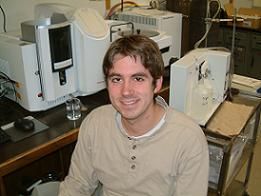Analysis of Associated Bedrock-Aquifer System Sediments: Origins of Electron Donor-Rich Aquifers in Eastern North Dakota

Ryan Klapperich is a M.S. (Geology) student at the University of North Dakota in Grand Forks, ND. He graduated with a B.S. in Geology from UND in May of 2005. As an undergraduate, Ryan developed an interest in hydrogeology which lead him to continue with his Masters at the University of North Dakota. Ryan’s research interests include denitrification, hydrogeochemistry, and bedrock-aquifer relationships. His Master’s Degree project combines aspects of denitrification research with traditional sedimentological study.
Email: ryan.klapperich@und.edu
Fellow: Ryan Klapperich, Geology and Geological Engineering Department, UND
Advisor: Dr. Scott F. Korom, Associate Professor of Geology, University of North Dakota
Committee Members: Dr. Philip J. Gerla and Dr. Richard D. LeFever
Matching Support: UND
Degree Progress: M.S. in Geology expected December 2007 .
Analysis of Associated Bedrock-Aquifer System Sediments: Origins of Electron Donor-Rich Aquifers in Eastern North Dakota
Nitrate pollution has long been recognized as the most prevalent form of groundwater pollution. The only effective process to remediate nitrate contaminants is denitrification, typically through natural attenuation. This process reduces nitrate (NO3-) to harmless nitrogen gas. The process occurs naturally, requiring only an oxygen-limited environment, the presence of nitrogen digesting bacteria, and the availability of electron donors. The three most common electron donors are organic carbon, sulfide (typically as pyrite, FeS2), and ferrous iron minerals. Research has also shown that the controlling factor in this reaction has typically been the availability of suitable electron donors within the aquifer sediments.
The long-term goal of this research is to develop an aquifer nitrate vulnerability index based on the supply of electron donors in the aquifer sediments. This project contributes toward that goal by considering the abundance of electron donors in the likely parent materials comprising the aquifer sediments. Based on the experience of previous UND denitrification research and literature reports, shale units are more likely to have large supplies of electron donors than other regional rock types. Shale is relatively soft and easily weathered and comprises much of the bedrock in eastern North Dakota. Therefore, shale units are the most likely contributors to sediments in nearby aquifers. My hypothesis is that regional bedrock units rich in electron donors should correlate to nearby aquifer sediments that are potentially rich in electron donors. The practical utility of this work is that an initial list of aquifers with potentially high denitrification capacities in North Dakota may be made using geological investigations. Later, more extensive and more expensive geochemical analyses would be necessary to confirm the denitrification capacity of specific aquifers and specific aquifer sites. However, much of the initial work could be done with data already available and in conjunction with future drilling performed by the North Dakota State Water Commission (NDSWC).
Progress to Date:
Geochemical analysis and literature review are ongoing. The bedrock samples were collected this previous summer in conjunction with the State Water Commission. They were collected in a general east to west transect across Stustman, Foster, and Steele counties. Two to three samples were collected when the shale was penetrated, representing an upper and lower, and occasionally mid-level sample. Samples from Kidder, Benson, Nelson, and Cass Counties have also been provided from other drilling projects. In total there are 39 samples representing 21 different sites and seven lithologic units. XRD analysis has been preformed on many of the samples and shows that the shale units are rich in quartz, clay minerals, and occasionally calcite, as was expected. Pyrite, micas, and iron bearing minerals have also been detected. XRD has also verified that the lithologic units are generally uniform in space and depth, meaning a single sample can be considered representative. Organic carbon analysis shows distinct differences between the formations. The Carlisle and Greenhorn formations have significantly higher values of OC than the Pierre or Niobrara formations. Inorganic sulfide analysis to date also suggests some formations have significant quantities of sulfide (as S-) available. This data suggests the shales contain similar levels of electron donors as nearby aquifers.
Significance:
This research investigates the link between the denitrification capacities of eastern North Dakota aquifers with the electron donor composition of the surrounding bedrock. If such a link exists, a qualitative index (low, medium, and high) of aquifer denitrification capacity based on the probable source of the parent material will be developed. This index could then be used to focus, in a cost-effective fashion, more extensive and expensive geochemical analysis on specific aquifers or zones in specific aquifers.
Presentations:
Klapperich, R. J. and S. F. Korom. 2007. Analysis of Associated Bedrock-Aquifer System Sediments: Origins of Electron Donor-Rich Aquifers in Eastern North Dakota. University of North Dakota Graduate School Scholarly Forum. Grand Forks, ND. March 1.

Scott F. Korom
Geology & Geological Engineering
UND


